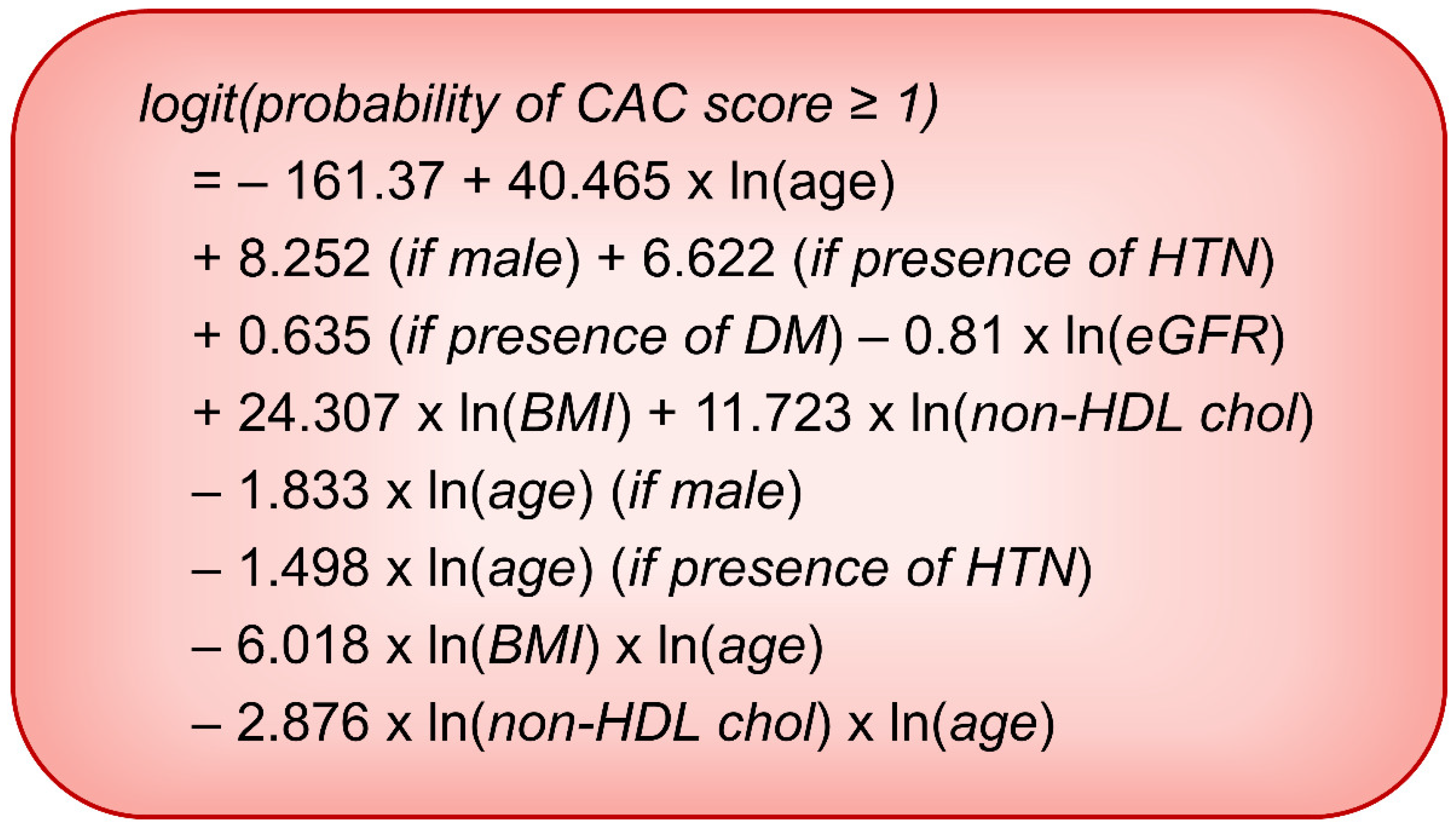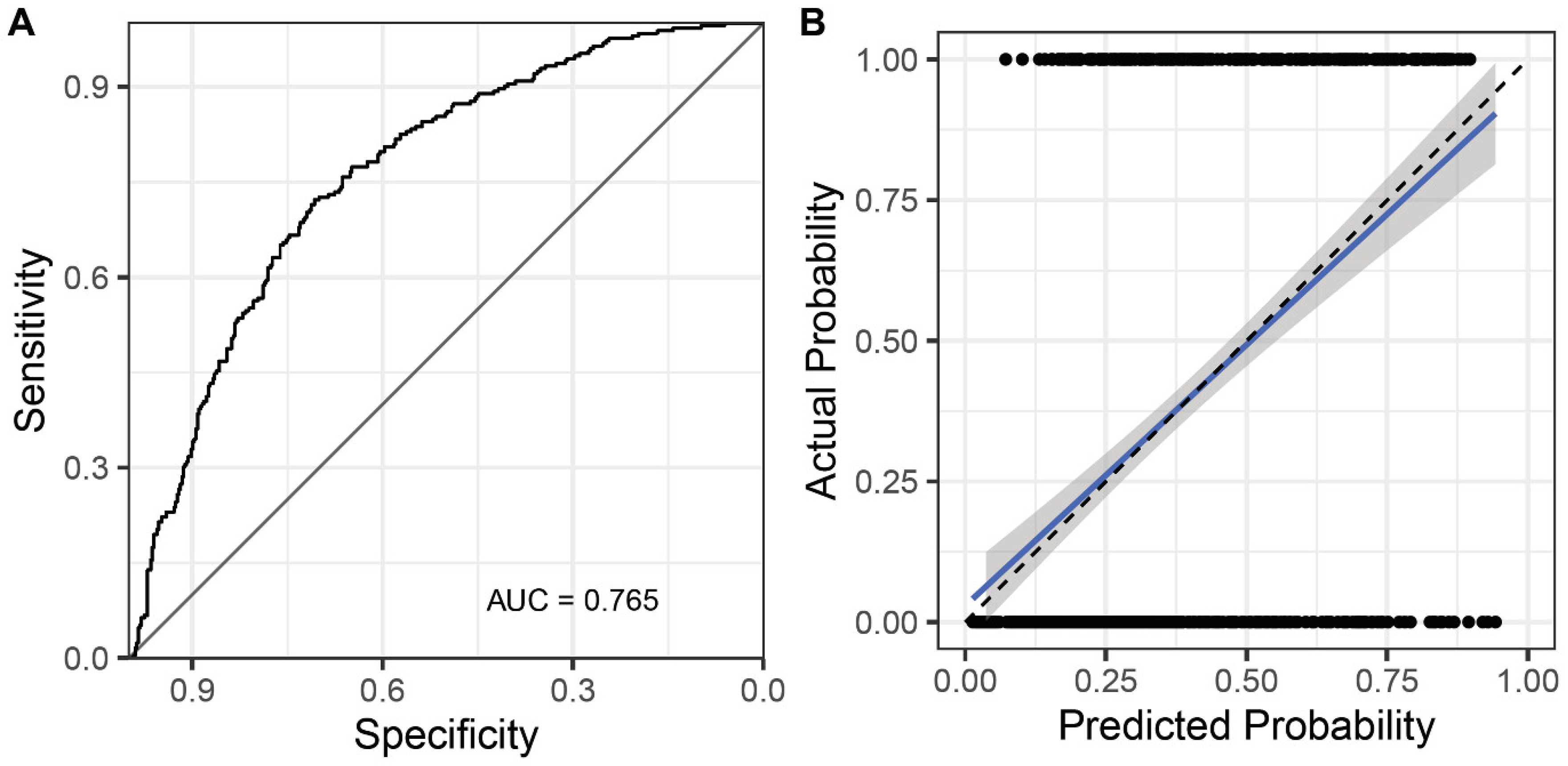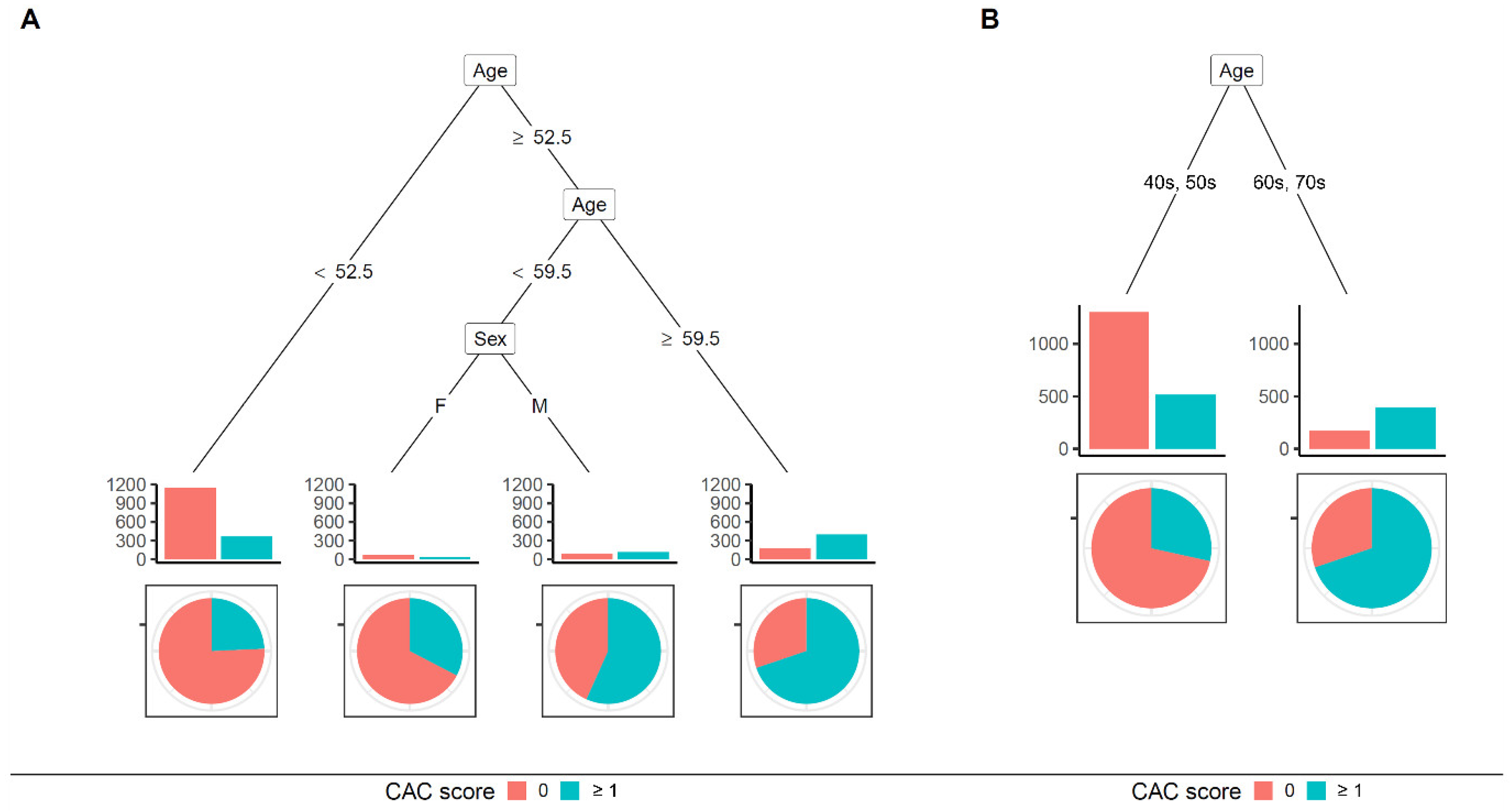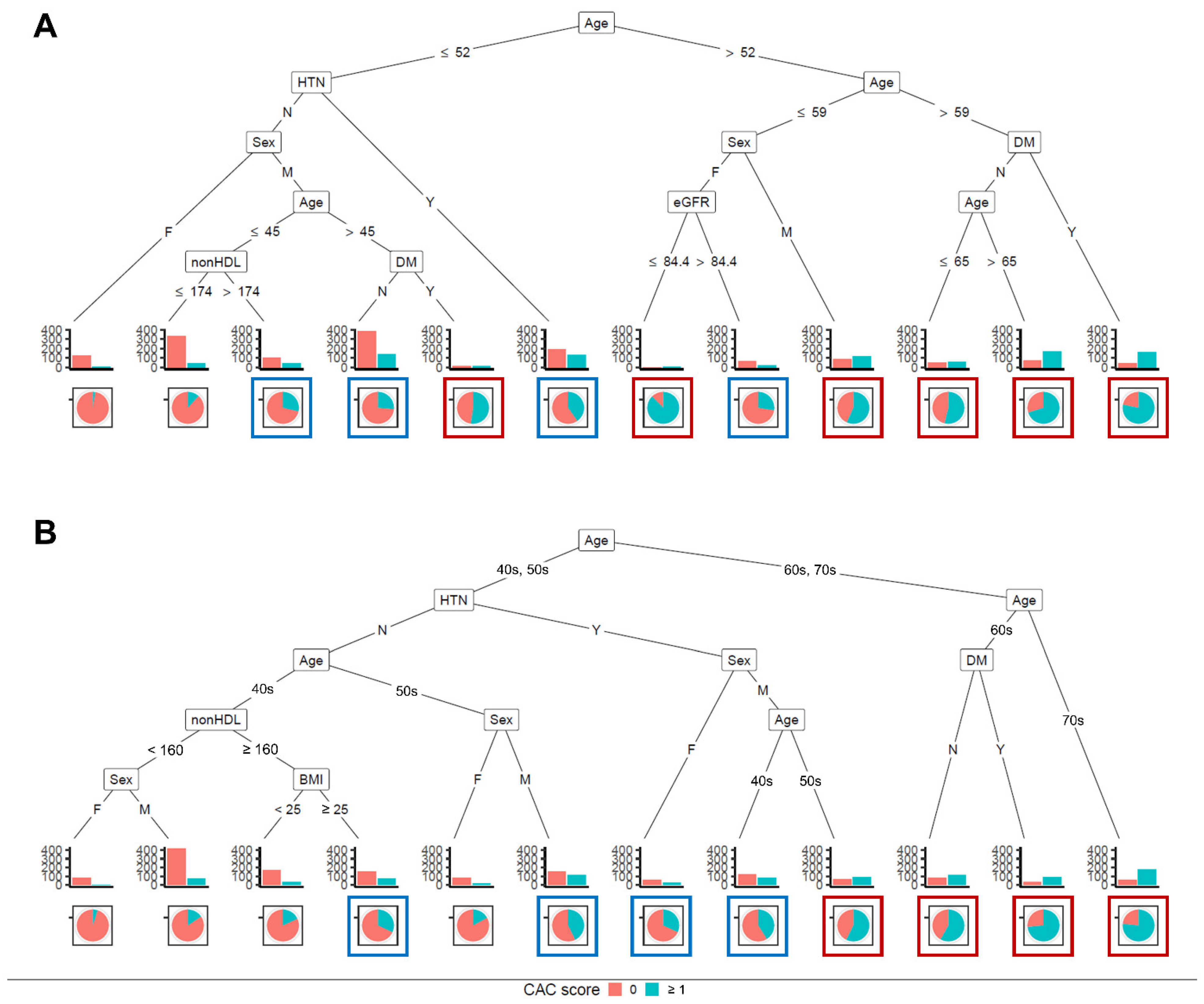New Model for Predicting the Presence of Coronary Artery Calcification
Abstract
1. Introduction
2. Materials and Methods
2.1. Study Population and Design
2.2. Covariates and STUDY Outcome
2.3. Statistical Analyses
3. Results
3.1. Characteristics of the Cohorts
3.2. Logistic Regression Models
3.3. Classification Trees
4. Discussion
5. Conclusions
Author Contributions
Funding
Institutional Review Board Statement
Informed Consent Statement
Data Availability Statement
Conflicts of Interest
References
- Demer, L.L.; Tintut, Y. Vascular calcification: Pathobiology of a multifaceted disease. Circulation 2008, 117, 2938–2948. [Google Scholar] [CrossRef] [PubMed]
- Arnett, D.K.; Blumenthal, R.S.; Albert, M.A.; Buroker, A.B.; Goldberger, Z.D.; Hahn, E.J.; Himmelfarb, C.D.; Khera, A.; Lloyd-Jones, D.; McEvoy, J.W.; et al. 2019 ACC/AHA Guideline on the Primary Prevention of Cardiovascular Disease: A Report of the American College of Cardiology/American Heart Association Task Force on Clinical Practice Guidelines. Circulation 2019, 140, e596–e646. [Google Scholar] [CrossRef] [PubMed]
- Greenland, P.; Blaha, M.J.; Budoff, M.J.; Erbel, R.; Watson, K.E. Coronary Calcium Score and Cardiovascular Risk. J. Am. Coll. Cardiol. 2018, 72, 434–447. [Google Scholar] [CrossRef] [PubMed]
- Sarwar, A.; Shaw, L.J.; Shapiro, M.D.; Blankstein, R.; Hoffmann, U.; Cury, R.C.; Abbara, S.; Brady, T.J.; Budoff, M.J.; Blumenthal, R.S.; et al. Diagnostic and prognostic value of absence of coronary artery calcification. JACC Cardiovasc. Imaging 2009, 2, 675–688. [Google Scholar] [CrossRef]
- Van Kempen, B.J.; Ferket, B.S.; Steyerberg, E.W.; Max, W.; Myriam Hunink, M.G.; Fleischmann, K.E. Comparing the cost-effectiveness of four novel risk markers for screening asymptomatic individuals to prevent cardiovascular disease (CVD) in the US population. Int. J. Cardiol. 2016, 203, 422–431. [Google Scholar] [CrossRef]
- Hong, J.C.; Blankstein, R.; Shaw, L.J.; Padula, W.V.; Arrieta, A.; Fialkow, J.A.; Blumenthal, R.S.; Blaha, M.J.; Krumholz, H.M.; Nasir, K. Implications of Coronary Artery Calcium Testing for Treatment Decisions Among Statin Candidates According to the ACC/AHA Cholesterol Management Guidelines: A Cost-Effectiveness Analysis. JACC Cardiovasc. Imaging 2017, 10, 938–952. [Google Scholar] [CrossRef]
- Kronmal, R.A.; McClelland, R.L.; Detrano, R.; Shea, S.; Lima, J.A.; Cushman, M.; Bild, D.E.; Burke, G.L. Risk factors for the progression of coronary artery calcification in asymptomatic subjects: Results from the Multi-Ethnic Study of Atherosclerosis (MESA). Circulation 2007, 115, 2722–2730. [Google Scholar] [CrossRef]
- Gassett, A.J.; Sheppard, L.; McClelland, R.L.; Olives, C.; Kronmal, R.; Blaha, M.J.; Budoff, M.; Kaufman, J.D. Risk Factors for Long-Term Coronary Artery Calcium Progression in the Multi-Ethnic Study of Atherosclerosis. J. Am. Heart Assoc. 2015, 4, e001726. [Google Scholar] [CrossRef]
- Rhee, E.J.; Kim, J.H.; Park, H.J.; Park, S.E.; Oh, H.G.; Park, C.Y.; Lee, W.Y.; Oh, K.W.; Park, S.W. Increased risk for development of coronary artery calcification in insulin-resistant subjects who developed diabetes: 4-year longitudinal study. Atherosclerosis 2016, 245, 132–138. [Google Scholar] [CrossRef]
- Cho, J.H.; Lee, D.Y.; Lee, E.S.; Kim, J.; Park, S.E.; Park, C.Y.; Lee, W.Y.; Oh, K.W.; Park, S.W.; Rhee, E.J. Increased risk of coronary artery calcification progression in subjects with high baseline Lp(a) levels: The Kangbuk Samsung Health Study. Int. J. Cardiol. 2016, 222, 233–237. [Google Scholar] [CrossRef]
- Rhee, E.J.; Cho, J.H.; Kwon, H.; Park, S.E.; Park, C.Y.; Oh, K.W.; Park, S.W.; Lee, W.Y. Association Between Coronary Artery Calcification and the Hemoglobin Glycation Index: The Kangbuk Samsung Health Study. J. Clin. Endocrinol. Metab. 2017, 102, 4634–4641. [Google Scholar] [CrossRef] [PubMed]
- Kim, J.; Lee, D.Y.; Park, S.E.; Park, C.Y.; Lee, W.Y.; Oh, K.W.; Park, S.W.; Rhee, E.J. Increased risk for development of coronary artery calcification in subjects with non-alcoholic fatty liver disease and systemic inflammation. PLoS ONE 2017, 12, e0180118. [Google Scholar] [CrossRef] [PubMed]
- Rhee, E.J.; Seo, M.H.; Kim, J.D.; Jeon, W.S.; Park, S.E.; Park, C.Y.; Oh, K.W.; Park, S.W.; Lee, W.Y. Metabolic health is more closely associated with coronary artery calcification than obesity. PLoS ONE 2013, 8, e74564. [Google Scholar] [CrossRef] [PubMed]
- Yu, J.H.; Yim, S.H.; Yu, S.H.; Lee, J.Y.; Kim, J.D.; Seo, M.H.; Jeon, W.S.; Park, S.E.; Park, C.Y.; Lee, W.Y.; et al. The relationship of body composition and coronary artery calcification in apparently healthy korean adults. Endocrinol. Metab. 2013, 28, 33–40. [Google Scholar] [CrossRef]
- Moon, B.S.; Park, H.J.; Lee, M.K.; Jeon, W.S.; Park, S.E.; Park, C.Y.; Lee, W.Y.; Oh, K.W.; Park, S.W.; Rhee, E.J. Increased association of coronary artery calcification in apparently healthy Korean adults with hypertriglyceridemic waist phenotype: The Kangbuk Samsung Health Study. Int. J. Cardiol. 2015, 194, 78–82. [Google Scholar] [CrossRef]
- Seo, M.H.; Rhee, E.J.; Park, S.E.; Park, C.Y.; Oh, K.W.; Park, S.W.; Lee, W.Y. Metabolic syndrome criteria as predictors of subclinical atherosclerosis based on the coronary calcium score. Korean J. Intern. Med. 2015, 30, 73–81. [Google Scholar] [CrossRef]
- Park, J.; Lee, E.S.; Lee, D.Y.; Kim, J.; Park, S.E.; Park, C.Y.; Lee, W.Y.; Oh, K.W.; Park, S.W.; Rhee, E.J. Waist Circumference as a Marker of Obesity Is More Predictive of Coronary Artery Calcification than Body Mass Index in Apparently Healthy Korean Adults: The Kangbuk Samsung Health Study. Endocrinol. Metab. 2016, 31, 559–566. [Google Scholar] [CrossRef]
- Chae, H.B.; Lee, S.Y.; Kim, N.H.; Han, K.J.; Lee, T.H.; Jang, C.M.; Yoo, K.M.; Park, H.J.; Lee, M.K.; Jeon, W.S.; et al. Age Is the Strongest Effector for the Relationship between Estimated Glomerular Filtration Rate and Coronary Artery Calcification in Apparently Healthy Korean Adults. Endocrinol. Metab. 2014, 29, 312–319. [Google Scholar] [CrossRef]
- Lee, M.K.; Park, H.J.; Jeon, W.S.; Park, S.E.; Park, C.Y.; Lee, W.Y.; Oh, K.W.; Park, S.W.; Rhee, E.J. Higher association of coronary artery calcification with non-alcoholic fatty liver disease than with abdominal obesity in middle-aged Korean men: The Kangbuk Samsung Health Study. Cardiovasc. Diabetol. 2015, 14, 88. [Google Scholar] [CrossRef]
- Marshall, R.J. The use of classification and regression trees in clinical epidemiology. J. Clin. Epidemiol. 2001, 54, 603–609. [Google Scholar] [CrossRef]
- Hothorn, T.; Hornik, K.; Zeileis, A. Unbiased recursive partitioning: A conditional inference framework. J. Comput. Graph. Stat. 2006, 15, 651–674. [Google Scholar] [CrossRef]
- Breiman, L. Random forests. Mach. Learn. 2001, 45, 5–32. [Google Scholar] [CrossRef]
- Rhee, E.J.; Kim, H.C.; Kim, J.H.; Lee, E.Y.; Kim, B.J.; Kim, E.M.; Song, Y.; Lim, J.H.; Kim, H.J.; Choi, S.; et al. 2018 Guidelines for the management of dyslipidemia. Korean J. Intern. Med. 2019, 34, 723–771. [Google Scholar] [CrossRef]
- Inoue, S.; Zimmet, P.; Caterson, I.; Chunming, C.; Ikeda, Y.; Khalid, A.; Kim, Y. The Asia-Pacific Perspective: Redefining Obesity and Its Treatment; Health Communications Australia Pty Ltd.: Sydney, Australia, 2000. [Google Scholar]
- Kdigo, C.; Work Group. KDIGO 2012 clinical practice guideline for the evaluation and management of chronic kidney disease. Kidney Int. Suppl. 2013, 3, 1–150. [Google Scholar]
- Mori, H.; Torii, S.; Kutyna, M.; Sakamoto, A.; Finn, A.V.; Virmani, R. Coronary Artery Calcification and its Progression: What Does it Really Mean? JACC Cardiovasc. Imaging 2018, 11, 127–142. [Google Scholar] [CrossRef]
- Detrano, R.; Guerci, A.D.; Carr, J.J.; Bild, D.E.; Burke, G.; Folsom, A.R.; Liu, K.; Shea, S.; Szklo, M.; Bluemke, D.A.; et al. Coronary calcium as a predictor of coronary events in four racial or ethnic groups. N. Engl. J. Med. 2008, 358, 1336–1345. [Google Scholar] [CrossRef]
- McClelland, R.L.; Jorgensen, N.W.; Budoff, M.; Blaha, M.J.; Post, W.S.; Kronmal, R.A.; Bild, D.E.; Shea, S.; Liu, K.; Watson, K.E.; et al. 10-Year Coronary Heart Disease Risk Prediction Using Coronary Artery Calcium and Traditional Risk Factors: Derivation in the MESA (Multi-Ethnic Study of Atherosclerosis) With Validation in the HNR (Heinz Nixdorf Recall) Study and the DHS (Dallas Heart Study). J. Am. Coll. Cardiol. 2015, 66, 1643–1653. [Google Scholar] [CrossRef]
- Greenland, P.; LaBree, L.; Azen, S.P.; Doherty, T.M.; Detrano, R.C. Coronary artery calcium score combined with Framingham score for risk prediction in asymptomatic individuals. JAMA 2004, 291, 210–215. [Google Scholar] [CrossRef]
- Budoff, M.J.; Young, R.; Burke, G.; Jeffrey Carr, J.; Detrano, R.C.; Folsom, A.R.; Kronmal, R.; Lima, J.A.C.; Liu, K.J.; McClelland, R.L.; et al. Ten-year association of coronary artery calcium with atherosclerotic cardiovascular disease (ASCVD) events: The multi-ethnic study of atherosclerosis (MESA). Eur. Heart J. 2018, 39, 2401–2408. [Google Scholar] [CrossRef]
- McClelland, R.L.; Chung, H.; Detrano, R.; Post, W.; Kronmal, R.A. Distribution of coronary artery calcium by race, gender, and age: Results from the Multi-Ethnic Study of Atherosclerosis (MESA). Circulation 2006, 113, 30–37. [Google Scholar] [CrossRef]
- Gidding, S.S.; McMahan, C.A.; McGill, H.C.; Colangelo, L.A.; Schreiner, P.J.; Williams, O.D.; Liu, K. Prediction of coronary artery calcium in young adults using the Pathobiological Determinants of Atherosclerosis in Youth (PDAY) risk score: The CARDIA study. Arch. Intern. Med. 2006, 166, 2341–2347. [Google Scholar] [CrossRef] [PubMed]
- Lee, J.; Lim, J.S.; Chu, Y.; Lee, C.H.; Ryu, O.H.; Choi, H.H.; Park, Y.S.; Kim, C. Prediction of Coronary Artery Calcium Score Using Machine Learning in a Healthy Population. J. Pers. Med. 2020, 10, 96. [Google Scholar] [CrossRef] [PubMed]






| Variables | Total Cohorts (n = 3302) | Cheonan (n = 1358) | Kangbuk Samsung (n = 1944) |
|---|---|---|---|
| Age, year | 49 (45–58) | 61 (53–69) | 46 (43–49) |
| 40–49, n (%) | 1708 (51.7) | 196 (14.4) | 1512 (77.8) |
| 50–59, n (%) | 815 (24.7) | 399 (29.4) | 416 (21.4) |
| 60–69, n (%) | 453 (13.7) | 439 (32.3) | 14 (0.7) |
| 70–75, n (%) | 326 (9.9) | 324 (23.9) | 2 (0.1) |
| Male, n (%) | 2502 (75.8) | 718 (52.9) | 1784 (91.8) |
| HTN, n (%) | 1145 (34.7) | 803 (59.1) | 342 (17.6) |
| DM, n (%) | 495 (15.0) | 455 (33.5) | 40 (2.1) |
| eGFR, ml/min per 1.73 m2 | 97.9 (88.3–104.5) | 98.4 (90.5–105.1) | 97.5 (87.7–104.2) |
| ≥90, n (%) | 2307 (69.9) | 1029 (75.8) | 1278 (65.7) |
| 60–89, n (%) | 995 (30.1) | 329 (24.2) | 666 (34.3) |
| BMI, kg/m2 | 24.6 (22.8–26.7) | 24.7 (22.7–26.9) | 24.6 (22.9–26.6) |
| <25, n (%) | 1802 (54.6) | 732 (53.9) | 1070 (55.0) |
| ≥25, n (%) | 1500 (45.4) | 626 (46.1) | 874 (45.0) |
| non-HDL, mg/dL | 146 (120–173) | 135 (109–165) | 153 (129–177) |
| <100, n (%) | 376 (11.4) | 246 (18.1) | 130 (6.7) |
| 100–129, n (%) | 727 (22.0) | 359 (26.4) | 368 (18.9) |
| 130–159, n (%) | 987 (29.9) | 355 (26.1) | 632 (32.5) |
| 160–189, n (%) | 747 (22.6) | 240 (17.7) | 507 (26.1) |
| ≥190, n (%) | 465 (14.1) | 158 (11.6) | 307 (15.8) |
| CACS, units | 0 (0–26) | 6 (0–129) | 0 (0–1) |
| 0, n (%) | 2039 (61.8) | 601 (44.3) | 1438 (74.0) |
| 1–100, n (%) | 790 (23.9) | 375 (27.6) | 415 (21.3) |
| >100, n (%) | 473 (14.3) | 382 (28.1) | 91 (4.7) |
| Variables | Basic Model | Best AIC Model | ||
|---|---|---|---|---|
| Coefficients, β | p Value | Coefficients, β | p Value | |
| (Intercept) | −182.013 | <0.001 | −161.37 | <0.001 |
| Ln (Age) | 45.716 | <0.001 | 40.465 | <0.001 |
| Male | 8.516 | 0.011 | 8.252 | 0.013 |
| HTN | 6.302 | 0.011 | 6.622 | 0.007 |
| DM | 3.917 | 0.263 | 0.635 | <0.001 |
| Ln (eGFR) | 3.259 | 0.708 | −0.81 | 0.035 |
| Ln (BMI) | 23.992 | 0.008 | 24.307 | 0.007 |
| Ln (non-HDL) | 12.269 | 0.003 | 11.723 | 0.004 |
| Interaction | ||||
| Sex * Ln (age) | −1.898 | 0.021 | −1.833 | 0.025 |
| HTN * Ln (age) | −1.419 | 0.023 | −1.498 | 0.015 |
| DM * Ln (age) | −0.81 | 0.347 | ||
| Ln (eGFR) * Ln (age) | −1.035 | 0.638 | ||
| Ln (BMI) * Ln(age) | −5.94 | 0.009 | −6.018 | 0.008 |
| Ln (non-HDL) * Ln (age) | −3.014 | 0.003 | −2.876 | 0.005 |
| C-Statistics | Kappa | Acc and 95% CI | Sen | Spe | PPV | NPV | |
|---|---|---|---|---|---|---|---|
| LRM | 0.765 (0.728–0.801) | 0.350 | 70.71 (67.08–74.16) | 49.60 | 83.78 | 65.45 | 72.86 |
| CART | 0.690 (0.652–0.728) | 0.375 | 71.32 (67.70~74.75) | 55.16 | 81.33 | 64.65 | 74.55 |
| CARTcat | 0.638 (0.603–0.672) | 0.298 | 69.35 (65.67–72.85) | 40.08 | 87.47 | 66.45 | 70.22 |
| CIT | 0.751 (0.714–0.788) | 0.379 | 71.32 (67.70–74.75) | 56.75 | 80.34 | 64.13 | 75.00 |
| CITcat | 0.759 (0.722–0.796) | 0.334 | 69.95 (66.29–73.43) | 48.81 | 83.05 | 64.06 | 72.38 |
| RF | 0.753 (0.715–0.791) | 0.355 | 71.02 (67.39–74.46) | 49.21 | 84.52 | 66.31 | 72.88 |
Publisher’s Note: MDPI stays neutral with regard to jurisdictional claims in published maps and institutional affiliations. |
© 2021 by the authors. Licensee MDPI, Basel, Switzerland. This article is an open access article distributed under the terms and conditions of the Creative Commons Attribution (CC BY) license (http://creativecommons.org/licenses/by/4.0/).
Share and Cite
Park, S.; Hong, M.; Lee, H.; Cho, N.-j.; Lee, E.-Y.; Lee, W.-Y.; Rhee, E.-J.; Gil, H.-W. New Model for Predicting the Presence of Coronary Artery Calcification. J. Clin. Med. 2021, 10, 457. https://doi.org/10.3390/jcm10030457
Park S, Hong M, Lee H, Cho N-j, Lee E-Y, Lee W-Y, Rhee E-J, Gil H-W. New Model for Predicting the Presence of Coronary Artery Calcification. Journal of Clinical Medicine. 2021; 10(3):457. https://doi.org/10.3390/jcm10030457
Chicago/Turabian StylePark, Samel, Min Hong, HwaMin Lee, Nam-jun Cho, Eun-Young Lee, Won-Young Lee, Eun-Jung Rhee, and Hyo-Wook Gil. 2021. "New Model for Predicting the Presence of Coronary Artery Calcification" Journal of Clinical Medicine 10, no. 3: 457. https://doi.org/10.3390/jcm10030457
APA StylePark, S., Hong, M., Lee, H., Cho, N.-j., Lee, E.-Y., Lee, W.-Y., Rhee, E.-J., & Gil, H.-W. (2021). New Model for Predicting the Presence of Coronary Artery Calcification. Journal of Clinical Medicine, 10(3), 457. https://doi.org/10.3390/jcm10030457






